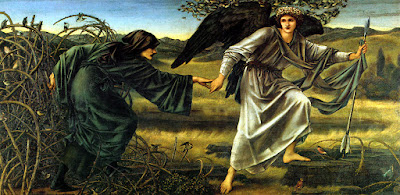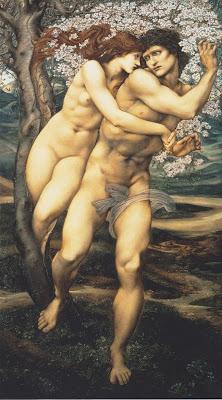I do so love to make new friends, especially writing friends with splendid books, and so was delighted to make the acquaintance of William Rose, author of the recently published The Strange Case of Madeleine Seguin.
The Strange Case of Madeleine Seguin centres on 1880s Paris and the growing interesting in science and its shady sister, magic. In the Salpêtrière Hospital, a mysterious patient Madeleine Seguin attracts a fair amount of interest, not only because she is attractive but also because her hysteria provides an exciting part of Professor Charcot's lectures. Madeleine proves a draw to everyone who meets her, from the doctors and fellow patients, to benefactors, priests and the young men from the growing Symbolist movement. One artist, Louis Martens, has a particular attachment to Madeleine and is encouraged in his companionship of the strange young woman, but there are far darker forces at work...
 |
| Images of a woman under Dr Charcott's use of hypnotism against hysteria (1878) |
Written in letters and case notes, The Strange Case of Madeleine Seguin is just the sort of novel I love. I have a weakness for epistolary novels and found myself galloping from one letter to the next, wanting to know the fate of the characters, to see if good would conquer evil. The setting of 1880s Paris is wonderfully conjured and I ended up wanting to know more about the Salpêtrière Hospital and its work, not to mention the many real people mentioned in the novel. I also found that it is not safe to Google 'Félicien Rops' at work...
 |
| Pornocrates (1878) Felcien Rops |
I thoroughly recommend The Strange Case of Madeleine Seguin for your summer reading. It's exciting, fascinating and a wonderful evocation of the edges of the fin de siècle. People hover between madness and sanity, monkeys lurk in darkened rooms and the devil is waiting for you. What more do you want from a novel?
After reading The Strange Case of Madeline Seguin, I had a few questions for William...
Q. What attracted you to 1880s Paris as a subject?
All the ingredients were there in Paris in the 1880s. I wanted to write about Symbolist artists and it was a centre for them. They were painting the ideas and imagery of dreams and the imagination. And Professor Jean-Martin Charcot was the 'Napoleon' of the huge Salpêtrière Hospital with its hundreds of (mainly) women suffering from 'hysteria'; a malady which in its own strange way also evokes dreams and the imagination. And Charcot was utilising the hypnotic trance in his treatment of these patients. The beginnings of the explorations into the unconscious mind were there and even, following his destiny, a young Freud, studying under Charcot. And the third ingredient, with a connection to the first two - there was a revival of occult practices at this time, in Paris as well as elsewhere. This brought the danger element into the story.
Q. The blend of real and fictional people in your novel works so well and had me reaching for Google to find out more about people. How did you choose who to include?
 |
| Jean-Martin Charcot |
Charcot was a must as I was writing about hysteria and hypnotism. His work at the Salpêtrière Hospital was where it happened. And anyway, he is a fascinating charismatic character. He had enemies among his rivals in the scientific community, but also he was adored by many of his students. Freud named one of his children after him. People flocked to his public lectures which could take in up to 400 people. And there he would describe the treatment of his patients along with 'live' demonstrations with hypnotism. And of course Madeleine is one of those. It was all grand theatre.
Felicien Rops is the main Symbolist artist in the story who actually existed. He easily lent himself to the narrative (thank you Felicien) as he was a larger than life character who increasingly utilised the occult for his subject matter. Very dark stuff. He was also a great charmer, a man who could retain masses of information and use it in conversation, and he was also known to be very effective in his erotic interactions with women.
I wanted Huysmans, Mallarmé, Jean Moréas and the Sâr Péladan in as they were important Symbolist literary figures of the time, and because they were personalities. But particularly I wanted to use them to really try to give a sense of the Symbolist culture and its origins.
The Maharajah, Jaswant Singh 11, certainly existed and in ways fitted, and the dates all match, but I had to allow my imagination much more leeway with that one.
Q. There is a lot of art in your novel, not just from the up-coming Symbolists but stretching back in time to other periods such as Rococo. For me, this reflected how the past can influence the mood of the present. How much does the art reflect the story of the book?
Bringing in art previous to the Symbolists was to allow for a greater range of imagery and not to get too exclusively focused on Symbolism. And I enjoy writing about artworks, so there is something of an indulgence in it. So they are all works described and artists that I like. I did also feel that the Parisian, ornate residence of the Countess ought to have the benefit of a beautiful and seductive Fragonard painting! And I managed to make reference to one of Rossetti's. Had to do that, because I like his work so much! But as to reflecting the story, it is art contemporary to that time in Paris, particularly the Symbolist, that does that, though the imagery of Gérôme's 'Academic' painting of 'Phryme' also has a special significance.
 |
| Phryne before the Areopagus (1861) Jean-Léon Gérôme |
Q. I am a big fan of Samuel Richardson, so I loved the fact that your novel is a collect of letters, but how did you come to choose a epistolary novel?
One of the aims of the narrative was to have a collection of documents: letters and case reports, concerning Madeleine, the central character. The fact that they exist is in itself part of the story. So in that sense it had to be epistolary. But that felt comfortable anyway and I enjoyed writing it in that style. I have had in mind Richardson, and also Bram Stoker's great novel 'Dracula', which is written in that style, and also 'The Woman in White' by Wilkie Collins, which I read for the first time quite recently and couldn't put down.
Q. What are you writing next?
Well, the next one is gradually progressing, but in early stages. I have become very interested in the nuns of the Carmelite contemplative order. It is I believe, the most closed and austere of them all. And the idea of those vows for life! So what happens when such a nun finds herself dreaming of Cupid? When the pagan mythology creeps into her night and her day dreams. And there can be a way (I think) of making reference in the narrative to the paintings that have depicted such scenes.

























































